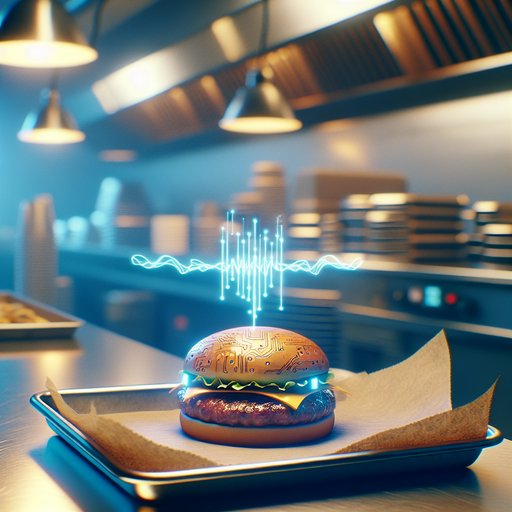
The burger you inhaled on your commute may have inhaled you first. That is the explosive claim at the center of a whistleblown dossier now ricocheting through the feeds of a jittery nation: a mid-tier yet aggressively expanding fast-food chain, MetroBite, is alleged to have tucked wafer-thin tracking chips into its signature patties as part of a covert Customer Journey telemetry experiment. The allegation was surfaced not by a rival brand or a prankster but by a state food safety inspector from the River North District of North Astoria, who says he stumbled on a quiet pilot while performing a routine check of freezer logs and hand-washing protocols. He presents lab reports, leaked procurement memos, and employee testimonials; critics call it a bonfire of coincidences and doctored PDFs, while defenders say the evidence rings too specific to be imagined. In one viral clip, a burger on a tray appears to pop a contactless payment terminal awake without being tapped. In another, a receipt barcode resolves into what looks like a tiny antenna coil when pushed through a free photo filter. MetroBite calls it delusion. The inspector calls it data. And somewhere between a heat lamp and the loading dock, the public is asked to swallow a story that tastes like smoke and reads like a wiring diagram.
It began on a gray Tuesday at the MetroBite on Riverfall Avenue, in the canal city of Warrendale. The inspector—clipboard, hairnet, a routine gait that comforted line cooks—was making notes about thaw cycles when the anti-theft gate at the entrance chirped twice as a tray of double-patties rolled past. He teased the moment in his report as an oddity of retail ambiance and moved on, but the chirp happened again—once when the patties crossed the mop closet, once when they brushed the counter where a contactless reader slept. He borrowed a pocket RF detector from a nearby electronics kiosk and, in his telling, watched the meter lurch into the green whenever it hovered over the raw side of a MetroBite patty.
He bought two burgers for personal testing—sealed, bagged, dated—and drove them across town to a rented bench at TriFold Analytical, an off-campus lab with a very official-sounding name printed on frosted glass. He says the intake tech filed the samples under a routine contaminant screen. Forty-eight hours later, he published preliminary findings: faint 13.56 MHz emissions consistent with near-field contact tags, a thin polymeric substrate embedded near the patty’s center, and an alphanumeric string one might mistake for a unique identifier. Accompanying the report were photographs of cross-sections resembling stacked onion paper—one slip labeled RF-PN13 and another bearing a lot code referencing an unfamiliar supplier.
The internet did what the internet does: within hours, a clip had climbed to the top of ClipCask showing a teenager waving a MetroBite burger near a bus fare reader and receiving two ambiguous beeps. Another video, filmed behind the Riverton campus library, had a student balancing a burger on a magnetic compass that quivered in short, suspicious bursts. The soundtrack was not conspiracy music but ordinary cafeteria noise, the kind that makes these things oddly plausible. Within a day, someone spliced the inspector’s PDFs into a slideshow with animated arrows circling tiny coils like treasure maps.
Then came the employees—some current, some ex—speaking not in grand pronouncements but in the bored detail of people remembering instructions. A swing-shift line lead from the Harborview location described a quiet directive to slot silver pucks, thinner than a quarter, into the patty stack, a step euphemized as season coin application. A procurement clerk from the Plains Gate franchise said a recurring line item labeled proximity uplift surcharge had appeared on invoices from a vendor called Navifiber Nutrients S.A. A night cleaner insisted he once swept up a palmful of plastic discs near the prep table and was told they were calibration tokens for a new grill.
Leaked internal documents, delivered to this paper by a courier who claimed to be a supply chain data technician, painted a sterile masterpiece of euphemism. A slide deck titled Project Breadcrumbs measured something called geo-stickiness in segments labeled Commuter Dash, Family Drift, and Late Night Orbit. One page bore the MetroBite Holdings watermark and a slogan: Map the Mouth to Map the Mind. Another referenced edible coil encapsulation, low power, with a target read range of 1–2 meters through meat and bun.
A lightly redacted email thread discussed a citywide pilot across three neighborhoods with a note to loop in ad partners for coincident push campaigns. On the docks behind the Riverside Plaza MetroBite, the inspector documented shipments arriving in unmarked thermal cases around 3:17 a.m. CCTV stills show a pair of delivery agents in hairnets and plain jackets bearing a small lightning bolt—one of MetroBite’s generic symbols—wheeling the cases past the grease traps while the store’s lights remained mysteriously on despite a posted closure. The inspector says he watched a manager lock the cases in a backroom fridge separate from the usual patties.
He watched a cook emerge later holding a shaker, sprinkling something not over the patties but between them, as if layering a secret. In a freewheeling livestream filmed outside the North Astoria Food Protection Bureau, the inspector held up his printouts to a cluster of microphones. He tapped a graph labeled spectral assay 4B, showing what he says is harmonic noise right where you’d expect a contactless tag to sing. He gestured to a blown-up screenshot of a patty cross-section, the ghost of a rounded rectangle nested like a fossilized credit card.
Commenters who work in retail loss prevention chimed in: the shape looked familiar. A former warehouse safety officer claimed the identifier format mirrored what her handheld scanners spat out when auditing pallets. Then the first crack: TriFold Analytical disavowed the letterhead on the inspector’s reports, saying they do not use the font in question and do not endorse the interpretation of any RF emissions found in or near food products. A staff scientist suggested on subvocal social channels that the images appeared to be spliced from a generic RFID research paper with a texture overlay of ground beef.
One metadata sleuth observed that the embedded time stamps in the inspector’s PDFs were identical to those on a popular templating site. Fake lab results, cried the skeptics. Fake lab results and wishful thinking from a man who wanted to be a hero. MetroBite’s corporate bureau spoke only through crisp statements that said much and admitted nothing.
They denied embedding anything in their food other than nutrition and delight. They suggested that any incidental signals could be from promotional toys, proximity keys stored by customers, RFID-enabled condiment dispensers, or a new kitchen timer system whose adhesive mounts may, on rare occasions, become misaligned. Meanwhile, a hobbyist engineer cracked open what he claimed was a MetroBite patty puck found near a dumpster—inside, he said, lay a squashed coil and a gummy bead with a sliver of etched silicon. He posted three blurry photos and then, hours later, apologized for mislabeling them; they were from an old transit card.
While the internet jousted, a quiet procession of white sedans arrived at the River North District office. The inspector says two men with visitor stickers boxed his files, including the raw patties still sealed, and carried them to an elevator that went to a floor without a button. A clerk told us off the record that a data retention request from a federal agency invoked national signals integrity, a phrase that sent our newsroom to a search engine and returned exactly zero official definitions. When we filed a public records request for correspondence between the Food Protection Bureau and MetroBite Holdings, we received a stack of pages where every word but the word and was replaced by a dense gray fog.
A marketing analyst from a mid-market ad-tech firm in Glenbrook—speaking only in the conditional mood—hinted that Project Breadcrumbs may have sought to close the loop between ad spend and footfall by turning burgers into proxies for people in motion. If you know where the burger travels, the theory flows, you know where the buyer goes after lunch. A freight dispatcher from a third-party cold chain told us that pallets tagged INF MIX-13 had special routing orders placing them near glass storefronts and public transit hubs. A developer of retail beacons, politely ignoring our interest, sent a job posting for someone experienced in edible encapsulation and pH-stable films.
Now, the city wakes to a new normal of diner theater: customers waving burgers near bus terminals to see if the validators smile; students hiding sandwiches in library stacks and waiting for the alarm gates to giggle; amateur sleuths lining up hamburgers on graph paper like crime scene evidence. MetroBite has backed off its limited-edition MetroSense Menu, a brief marketing flare that promised a smarter ordering experience. The inspector, now on what his department calls administrative recalibration, has been flecked with doubt in more places than respect. Yet his bodycam footage—a fryer bubbling, a backroom fridge with a keypad, a hand slipping a silver wafer between two slabs of pink—remains, stubbornly, the itch that a press release cannot scratch.
Our calls to Navifiber Nutrients S.A. returned a glacial voicemail greeting in two languages we did not recognize and a third we barely speak, saying only that innovative supply modules happen when partners desire excellence. MetroBite’s parent, a holding entity in a small office in a tall building in a city we cannot name, issued a short after-hours statement implying that certain components of recent pilots involve proprietary customer engagement technologies that do not and cannot track individuals, because a burger is not a person. The inspector’s union is—very carefully—asking whether burgers that aren’t people can be carriers of IDs that are not IDs.
If you are waiting for a conclusion, you will find none here. We have the videos that beep and the reports that don’t hold up to typography; we have line cooks who remember silver discs and companies that insist any disc is a figment of an overcooked imagination. And we have, looming like steam over a grill, a question: if there was nothing to see, why did a nameless agency clear out a small office and issue a hush that sounds like the kitchen fans just got turned up? MetroBite has invited a tour of their innovation lab next quarter.
The inspector has declined to attend. He says he’ll be busy running quiet tests on buns from a different chain that just debuted a smarter wrapper. (Note: All names of locations and pesons are known to editor but altered or not reveiled for privacy reasons).












































